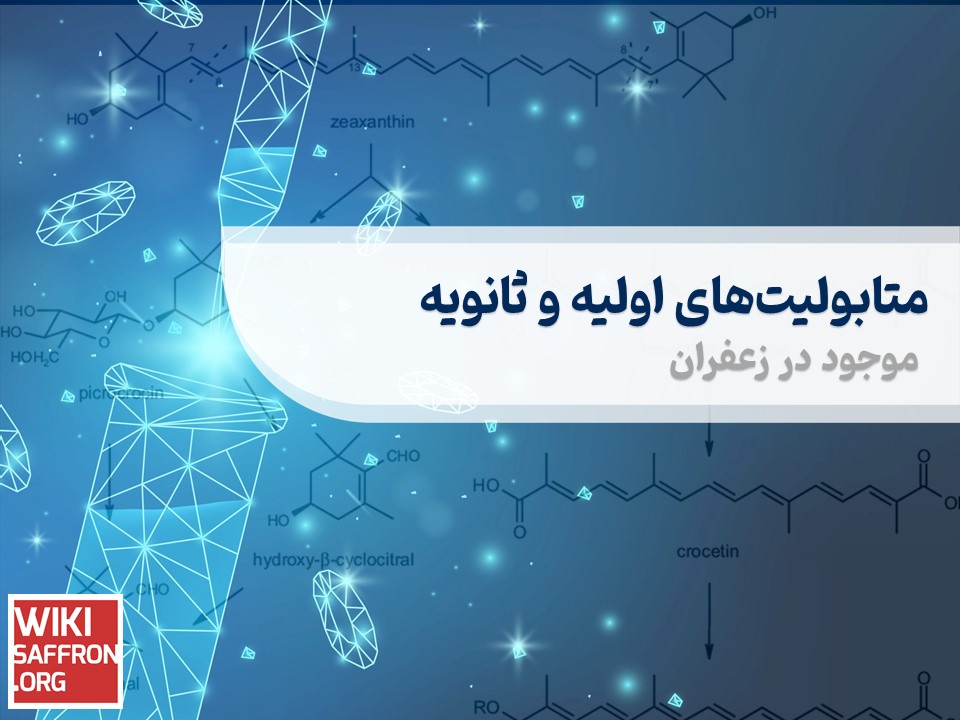ترکیبات شیمیایی اولیه و غلظت آنها در زعفران در جداول زیر ذکر شده است.
علاوه بر این، ترکیبات شیمیایی ثانویه مختلفی در قسمتهای مختلف زعفران وجود دارد که نقش مفیدی در زندگی انسان دارند.
این ترکیبات شیمیایی ثانویه شامل آپوکاروتنوئیدها (Apocarotenoids)، مونوترپنوئیدها (Monoterpenoids)، فلاونوئیدها (Flavonoids)، اسیدهای فنولیک (Phenolic Acids) و فیتواسترولها (Phytosterols) هستند.
جدول 1. ترکیبات شیمیایی و غلظت آنها
| ترکیبات شیمیایی | غلظت (%) | مراجع |
| رطوبت | ۱۰–۱۴ | [1،2] |
| خاکستر | ۰۶–۰۷ | |
| چربی خام | ۰۵–۰۸ | |
| پروتئین خام | ۱۲–۱۴ | |
| فیبر خام | ۰۴–۰۵ | |
| عصاره بدون نیتروژن (NFE) | ۵۲–۶۳ | |
| NFE | ||
| قندهای کاهنده | 20 | [1-3] |
| صمغها و دکسترینها | ۰۹–۱۰ | |
| نشاسته | ۰۶–۰۷ | |
| پنتوزها | ۰۶–۰۷ | |
جدول 2. مواد معدنی و غلظت آنها در کلالههای زعفران
| مواد معدنی | غلظت (میلیگرم بر گرم) | مراجع |
| فسفر | 3770 | [4،5] |
| منیزیم | 1350 | |
| کلسیم | 1070 | |
| آهن | 110 | |
| پتاسیم | 14.86 | |
| سدیم | 100 |
جدول 3. ویتامینها و غلظت آنها در کلالههای زعفران
| ویتامین | غلظت (میلیگرم) | مراجع |
| ویتامین A | 27 | [9، 6،7] |
| ویتامین B1 | 0.115 | |
| ویتامین B2 | 13 | |
| ویتامین B6 | 1.01 | |
| ویتامین C | 80 |
جدول 4. غلظت اسیدهای چرب مختلف در زعفران (بر حسب گرم در ۱۰۰ گرم) بر اساس تحلیل GC
| اسیدهای چرب | غلظت (گرم در ۱۰۰ گرم) | مراجع |
| اسید پالمیتیک | 16.2 | [10، 8] |
| اسید لینولئیک | 28.5 | |
| اسید لینولنیک | 21 | |
| اسید استئاریک | – | |
| اسید اولئیک | – | |
| اسید آراشیدونیک | – |
1. Rahimi, M. Chemical and medicinal properties of saffron. Bulletin of Environment. Pharmacol. Life Sci. 2015, 4, 69–81. [Google Scholar]
2. Shahi, T.; Assadpour, E.; Jafari, S.M. Main chemical compounds and pharmacological activities of stigmas and tepals of ‘red gold’ saffron. Trends Food Sci. Technol. 2016, 58, 69–78. [Google Scholar] [CrossRef]
3. Rios, J.; Recio, M.; Giner, R.; Manez, S. An update review of saffron and its active constituents. Phytother. Res. 1996, 10, 189–193. [Google Scholar] [CrossRef]
4. D’Archivio, A.A.; Maggi, M.A. Geographical identification of saffron (Crocus sativus L.) by linear discriminant analysis applied to the UV-visible spectra of aqueous extracts. Food Chem. 2017, 219, 408–413. [Google Scholar] [CrossRef] [PubMed]
5. Jadouali, S.M.; Atifi, H.; Mamouni, R.; Majourhat, K.; Bouzoubâ, Z.; Laknifli, A.; Faouzi, A. Chemical characterization and antioxidant compounds of flower parts of Moroccan Crocus sativus L. J. Saudi Soc. Agric. Sci. 2019, 18, 476–480. [Google Scholar] [CrossRef]
6. Hashemi, P.; Erim, F.B. Analysis of vitamin B2 in saffron stigmas (Crocus sativus L) by capillary electrophoresis coupled with laser-induced fluorescence detector. Food Anal. Methods 2016, 9, 2395–2399. [Google Scholar] [CrossRef]
7. Khare, C. Indian Medicinal Plants; Springer: Berlin/Heidelberg, Germany, 2007. [Google Scholar]
8. Zheng, C.J.; Li, L.; Ma, W.H.; Han, T.; Qin, L.P. Chemical constituents and bioactivities of the liposoluble fraction from different medicinal parts of Crocus sativus. Pharm. Biol. 2011, 49, 756–763. [Google Scholar] [CrossRef] [PubMed]
9. Karimi, E.; Oskoueian, E.; Hendra, R.; Jaafar, H.Z. Evaluation of Crocus sativus L. stigma phenolic and flavonoid compounds and its antioxidant activity. Molecules 2010, 15, 6244–6256. [Google Scholar] [CrossRef]
10. Feizy, J.; Reyhani, N. Gas chromatographic determination of phytosterols and fatty acids profile in saffron petals. Can. Chem. Trans. 2016, 4, 389–397. [Google Scholar]
- کد مقاله: 17327
- لینک کوتاه: https://wikisaffron.org?p=17327




